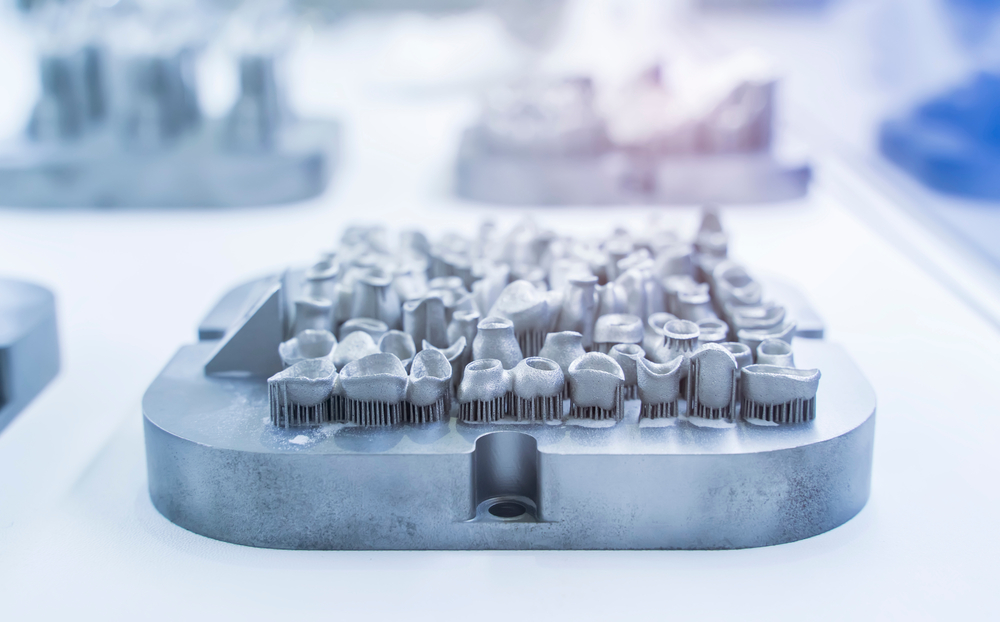
CNC Milling vs. 3D Printing Dental Crowns and Bridges
Digital dentistry has continued to expand with 3D printing of dental reconstruction parts like dental crowns and bridges. A dental crown is a tooth-shaped cap placed over a damaged tooth or dental implant and bonded with dental cement. They protect weak teeth, cover misshapen or worn down teeth, or hold a dental bridge in place. A dental bridge links replacement teeth with crowns on either end and replaces missing teeth. Two common ways to produce dental restoration implants are CNC milling or 3D printing.
3D printing is increasingly a more efficient method for producing dental parts such as aligners and retainers. Advanced 3D printing technology allows it to compete with traditional processes, such as CNC milling and sintering, to produce dental crowns and bridges.

CNC Milling and Sintering
The CNC milling process begins with a digital scan of the teeth to create a 3D CAD image. Zirconium dioxide, or zirconia, is often used to make dental crowns and bridges because of its proven durability.
To make a dental crown or bridge, a technician places a zirconia block or stock on a cutting disc for milling. After milling, the dental part is manually cut from the disc to begin post-processing such as sintering and polishing. The milled part is placed in an oven for sintering, usually overnight, and then removed for manual polishing. The technician then checks the accuracy of the fit for the dental part by comparing it to the digital scan. If the dental part fits, they coat it with a colored glaze to match the patient’s teeth and bake it to set the glaze.
3D Printing Dental Crowns and Bridges
3D printing simplifies the process by accurately printing the crown or dental bridge from the 3D CAD model with minimal post-processing. 3D printers can easily and rapidly print one or in parallel multiple dental crowns and bridges using advanced dental resins. Once printed, the dental part is washed, dried, and cured before being placed in the patient’s mouth.
Comparing CNC Milling and 3D Printing Dental Crowns and Bridges
Comparing 3D printing with CNC milling shows significant technology advances with 3D printing. See the advantages and disadvantages of each process:
| 3D Printing | CNC Milling | |
| Pros | -Advanced 3D printers can print within 30 to 50 microns, meeting accuracy requirements. -Entire printing and curing process for a dental part (or multiple parts in parallel) can finish in a day, allowing for same-day services. -Reduced material waste. -Ease-of-use and no tooling. -Can be more cost-effective than milling and have a better return on investment. | -Longevity of zirconia-based dental crowns and bridges. -Zirconium dioxide can withstand more force without chipping or breaking than other materials. |
| Cons | -Current dental resins are not as durable as zirconia, requiring eventual replacement of dental crown or bridge. | -Post-process sintering (after milling) shrinks parts by 30-40%, leading to accuracy issues if the shrinkage isn’t incorporated into the milling step. Sintering requires a longer processing time. -CNC milling is costly. -Specialized labor and manual processes increase overhead costs. -Modification of the implant during patient fitting will remove the colored glaze, causing a mismatch in the implant’s color. |
3D printing technologies will continue to improve, increasing the performance and durability of 3D printed dental crowns and bridges.
Benefitting From 3D Printing Dental Parts
3D printing simplifies the production of dental reconstruction parts by reducing labor costs and time for dental and orthodontic practices. LuxCreo offers high-performance 3D dental printers that use industry-leading dental resins, provide an intuitive workflow, and require minimal post-processing. Combined with LuxCreo’s dental software, the LuxCreo 3D dental printers deliver accurate and high-quality dental appliances for efficient production at dental labs and practices.
LuxCreo’s patented LEAP (Light Enabled Additive Production) process enables rapid and accurate 3D printing of dental reconstruction parts. For more information on how our advanced 3D printing solutions can streamline your dental part production, visit our contact page or call (650) 336-0888.